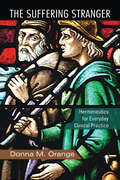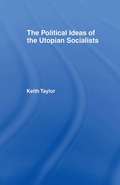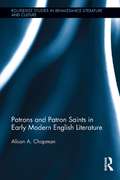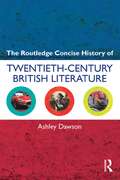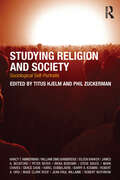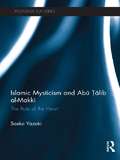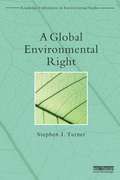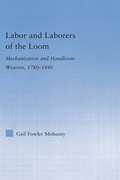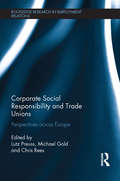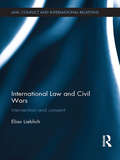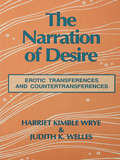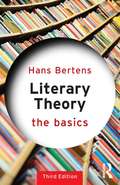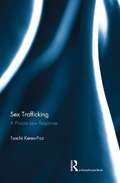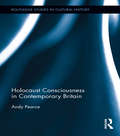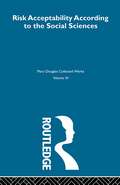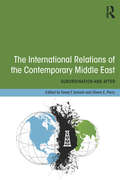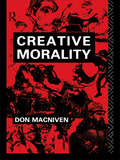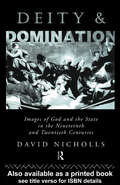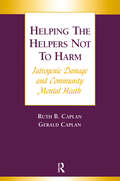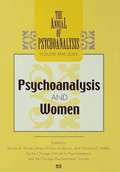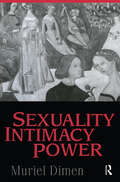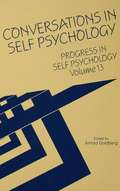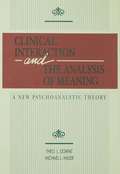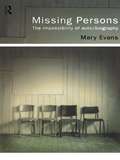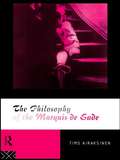Special Collections
Benetech’s Global Certified Accessible Titles
Description: Benetech’s GCA program is the first independent third-party EPUB certification to verify ebook accessibility. By creating content that is born accessible, publishers can meet the needs of all readers. Learn more: https://bornaccessible.benetech.org/
- Table View
- List View
The Suffering Stranger
by Donna M. OrangeWinner of the 2012 Gradiva Award! Utilizing the hermeneutics of Hans-Georg Gadamer and the ethics of Emmanuel Lévinas, The Suffering Stranger invigorates the conversation between psychoanalysis and philosophy, demonstrating how each is informed by the other and how both are strengthened in unison. Orange turns her critical (and clinical) eye toward five major psychoanalytic thinkers – Sándor Ferenczi, Frieda Fromm-Reichmann, D. W. Winnicott, Heinz Kohut, and Bernard Brandchaft – investigating the hermeneutic approach of each and engaging these innovative thinkers precisely as interpreters, as those who have seen the face and heard the voice of the other in an ethical manner. In doing so, she provides the practicing clinician with insight into the methodology of interpretation that underpins the day-to-day activity of analysis, and broadens the scope of possibility for philosophical extensions of psychoanalytic theory.
Political Ideas of the Utopian Socialists
by Keith TaylorFirst Published in 1982. Routledge is an imprint of Taylor & Francis, an informa company.
Patrons and Patron Saints in Early Modern English Literature
by Alison ChapmanThis book visits the fact that, in the pre-modern world, saints and lords served structurally similar roles, acting as patrons to those beneath them on the spiritual or social ladder with the word "patron" used to designate both types of elite sponsor. Chapman argues that this elision of patron saints and patron lords remained a distinctive feature of the early modern English imagination and that it is central to some of the key works of literature in the period. Writers like Jonson, Shakespeare, Spenser, Drayton, Donne and, Milton all use medieval patron saints in order to represent and to challenge early modern ideas of patronage -- not just patronage in the narrow sense of the immediate economic relations obtaining between client and sponsor, but also patronage as a society-wide system of obligation and reward that itself crystallized a whole culture’s assumptions about order and degree. The works studied in this book -- ranging from Shakespeare’s 2 Henry VI, written early in the 1590s, to Milton’s Masque Performed at Ludlow Castle, written in 1634 -- are patronage works, either aimed at a specific patron or showing a keen awareness of the larger patronage system. This volume challenges the idea that the early modern world had shrugged off its own medieval past, instead arguing that Protestant writers in the period were actively using the medieval Catholic ideal of the saint as a means to represent contemporary systems of hierarchy and dependence. Saints had been the ideal -- and idealized -- patrons of the medieval world and remained so for early modern English recusants. As a result, their legends and iconographies provided early modern Protestant authors with the perfect tool for thinking about the urgent and complex question of who owed allegiance to whom in a rapidly changing world.
The Routledge Concise History of Twentieth-Century British Literature
by Ashley DawsonIn The Routledge Concise History of Twentieth-Century British Literature Ashley Dawson identifies the key British writers and texts, shaped by era-defining cultural and historical events and movements from the period. He provides: Analysis of works by a diverse range of influential authors Examination of the cultural and literary impact of crucial historical, social, political and cultural events Discussion of Britain’s imperial status in the century and the diversification of the nation through Black and Asian British Literature Readers are also provided with a comprehensive timeline, a glossary of terms, further reading and explanatory text boxes featuring further information on key figures and events.
Studying Religion and Society
by Phil Zuckerman and Titus HjelmHow do you study religion and society? In this fascinating book, some of the most famous names in the field explain how they go about their everyday work of studying religions in the field. They explain how the ideas for their projects and books have come together, how their understanding of religion has changed over the years, and how their own beliefs have affected their work. They also comment on the changing nature of the field, the ideas which they regard as most important, and those which have not stood the test of time. Lastly they offer advice to young scholars, and suggest what needs to be done to enable the field to grow and develop further.
Islamic Mysticism and Abu Talib Al-Makki
by Saeko YazakiBoth in everyday language and religious metaphor, the heart often embodies the true self and is considered to be the seat of emotion in many cultures. Many Muslim thinkers have attempted to clarify the nature of Sufism using its metaphorical image, particularly in the tenth and eleventh centuries. This book examines the work of Abū Tālib al-Makkī and his wider significance within the Sufi tradition, with a focus on the role of the heart. Analysing his most significant work, Qūt al-qulūb (‘The Nourishment of Hearts’), the author goes beyond an examination of the themes of the book to explore its influence not only in the writing of Sufis, but also of Hanbalī and Jewish scholars. Providing a comprehensive overview of the world of al-Makkī and presenting extracts from his book on religious characteristics of the heart with selected passages in translation for the first time in English, this book will give readers a better understanding not only of the essential features of Sufism, but also the nature of mysticism and its relation to monotheistic faiths.
A Global Environmental Right
by Stephen TurnerThe development of an international substantive environmental right on a global level has long been a contested issue. To a limited extent environmental rights have developed in a fragmented way through different legal regimes. This book examines the potential for the development of a global environmental right that would create legal duties for all types of decision-makers and provide the bedrock for a new system of international environmental governance. Taking a problem solving approach, the book seeks to demonstrate how straightforward and logical changes to the existing global legal architecture would address some of the fundamental root causes of environmental degradation. It puts forward a draft global environmental right that would integrate duties for both state and non-state actors within reformed systems of environmental governance and a rational framework for business and industry to adhere to in order that those systems could be made operational. It also examines the failures of the existing international climate change regime and explains how the draft global environmental right could remedy existing deficits. This innovative and interdisciplinary book will be of great interest to policy-makers, students and researchers in international environmental law, climate change, environmental politics and global environmental governance as well as those studying the WTO, international trade law, human rights law, constitutional law and corporate law.
Labor and Laborers of the Loom
by Gail Fowler MohantyLabor and Laborers of the Loom: Mechanization and Handloom Weavers 1780-1840 develops several themes important to understanding the social, cultural and economic implications of industrialization. The examination of these issues within a population of extra-factory workers distinguishes this study. The volume centers on the rapid growth of handloom weaving in response to the introduction of water powered spinning. This change is viewed from the perspectives of mechanics, technological limitations, characteristics of weaving, skills, income and cost. In the works of Duncan Bythell and Norman Murray the displacement of British and Scottish hand weavers loomed large and the silence of American handloom weavers in similar circumstances was deafening. This study reflects the differences between the three culture by centering not on displacement but on survival. Persistence is closely tied to the gradual nature of technological change. The contrasts between independent commercial artisans and outwork weavers are striking. Displacement occurs but only among artisans devoting their time to independent workshop weaving. Alternatively outwork weavers adapted to changing markets and survived. The design and development of spinning and weaving device is stressed, as are the roles of economic conditions, management organization, size of firms, political implications and social factors contribute to the impact of technological change on outwork and craft weavers.
Corporate Social Responsibility and Trade Unions
by Chris Rees and Michael Gold and Lutz PreussGrowing interest in corporate social responsibility (CSR) has focused attention on the relationship between businesses and key stakeholders, such as NGOs and local communities. Curiously, however, commentators on CSR rarely discuss the role of trade unions, while commentators on employment relations seldom engage with CSR. This situation is all the more remarkable since unions are a critically important social actor and have traditionally played a prominent role in defending the interests of one key stakeholder in the company, the employee. Written by dedicated experts in their field, this book addresses a key gap in the literature on both CSR and employment relations, namely trade union policies towards CSR, as well as union engagement with particular CSR initiatives and the challenges they face in doing so. The research covers eleven European countries which, when taken together, constitute a representative sample of industrial relations structures across the continent. This book will be essential reading for scholars, students and practitioners of international business, employment relations, public policy and CSR. Its foreword is written by Philippe Pochet and Maria Jepsen, Directors of the European Trade Union Institute in Brussels.
International Law and Civil Wars
by Eliav LieblichThis book examines the international law of forcible intervention in civil wars, in particular the role of party-consent in affecting the legality of such intervention. In modern international law, it is a near consensus that no state can use force against another – the main exceptions being self-defence and actions mandated by a UN Security Council resolution. However, one more potential exception exists: forcible intervention undertaken upon the invitation or consent of a government, seeking assistance in confronting armed opposition groups within its territory. Although the latter exception is of increasing importance, the numerous questions it raises have received scant attention in the current body of literature. This volume fills this gap by analyzing the consent-exception in a wide context, and attempting to delineate its limits, including cases in which government consent power is not only negated, but might be transferred to opposition groups. The book also discusses the concept of consensual intervention in contemporary international law, in juxtaposition to traditional legal doctrines. It traces the development of law in this context by drawing from historical examples such as the Spanish Civil War, as well as recent cases such those of the Democratic Republic of the Congo, Somalia, Libya, and Syria. This book will be of much interest to students of international law, civil wars, the Responsibility to Protect, war and conflict studies, and IR in general.
The Narration of Desire
by Harriet K. Wrye and Judith K. WellesIn this richly woven study of preoedipal erotic experience, Harriet Kimble Wrye and Judith Welles focus on patients for whom early mothering did not sustain the flowering and subsequent transformation of early erotic desire. Such patients remain under the sway of a primitive eroticism that is often sadistic and invariably perverse. Successful analytic work requires accepting and containing the patient's primitive erotic needs; reconstructing the mother-infant narratives that sustain these needs; and mobilizing the patient's transformative desire to grow out of maternal eroticism to an adult love of self and others.
Literary Theory
by Hans BertensThis third edition of Hans Bertens' bestselling book is an essential guide to the often confusing and complicated world of literary theory. Exploring a broad range of topics from Marxist and feminist criticism to postmodernism and new historicism Literary Theory: The Basics covers contemporary topics including: reception theory and reader response theory the new criticism of postmodernism the 'after theory' debate post-humanism, biopolitics and animal studies aesthetics Literary Theory: The Basics helps readers to approach the many theories and debates in this field with confidence. Now with updated case studies and further reading this is an essential purchase for anyone who strives to understand literary theory today.
Sex Trafficking
by Tsachi Keren-PazSex Trafficking: A Private Law Response examines existing and potential causes of action against sex traffickers, clients and the state and argues for fair and effective private law remedies. Combining a theoretical inquiry about the borders of liability in torts and restitution with a political commitment to protecting the interests of victims of sex trafficking, this book offers a comparative doctrinal and socio-legal analysis of private law remedies, their justification, and their effectiveness. Tsachi Keren-Paz innovatively and convincingly makes the argument that all those directly involved in breaching the rights of victims of sex trafficking should compensate them for their losses, and make restitution of the profits made at their expense. Sex Trafficking: A Private Law Response will be invaluable to both academics and practitioners concerned with prostitution, modern slavery and trafficking, and those interested in private law theory and practice.
Holocaust Consciousness in Contemporary Britain
by Andy PearceThe Holocaust is a pervasive presence in British culture and society. Schools have been legally required to deliver Holocaust education, the government helps to fund student visits to Auschwitz, the Imperial War Museum's permanent Holocaust Exhibition has attracted millions of visitors, and Britain has an annually commemorated Holocaust Memorial Day. What has prompted this development, how has it unfolded, and why has it happened now? How does it relate to Britain's post-war history, its contemporary concerns, and the wider "globalisation" of Holocaust memory? What are the multiple shapes that British Holocaust consciousness assumes and the consequences of their rapid emergence? Why have the so-called "lessons" of the Holocaust enjoyed such popularity in Britain? Through analysis of changing engagements with the Holocaust in political, cultural and memorial landscapes over the past generation, this book addresses these questions, demonstrating the complexities of Holocaust consciousness and reflecting on the contrasting ways that history is used in Britain today.
Risk and Acceptability
by Mary DouglasFirst published in 1985, Mary Douglas intended Risk and Acceptability as a review of the existing literature on the state of risk theory. Unsatisfied with the current studies of risk, which she found to be flawed by individualistic and psychologistic biases, she instead uses the book to argue risk analysis from an anthropological perspective. Douglas raises questions about rational choice, the provision of public good and the autonomy of the individual.
The International Relations of the Contemporary Middle East
by Tareq Y. Ismael and Glenn E. PerryThe Middle East, a few decades ago, was seen to be an autonomous subsystem of the global international political system. More recently, the region has been subordinated to the hegemony of a singular superpower, the US, bolstered by an alliance with Israel and a network of Arab client states. The subordination of the contemporary Middle East has resulted in large part from the disappearance of countervailing forces, for example, global bipolarity, that for a while allowed the Arab world in particular to exercise a modicum of flexibility in shaping its international relations.The aspirations of the indigenous population of the Middle East have been stifled by the dynamics of the unequal global power relationships, and domestic politics of the countries of the region are regularly subordinated to the prerogatives of international markets and the strategic competition of the great powers. Employing the concept of imperialism, defined as a pattern of alliances between a center (rulers) in the Center (developed) country and a center (client regime) in the Periphery (underdeveloped country) - as an overall framework to analyse the subordination of the region, this book is essential reading for students and scholars of the Middle East, International Relations, and Politics in general.
Creative Morality
by Don MacNivenCreative Morality is a philosophical study of moral dilemmas. Western moral thought has relied on two basic ethical perspectives - Utilitarianism and Kantianism - to resolve dilemmas. MacNiven argues that no real progress can be made with modern moral problems unless these tradtions are coherently synthesised. The book deals with diverse topics such as academic honesty, medical confidentiality, terrorism and euthanasia and the hypothetical dilemmas used are based on real life situations so that theory might be tested against reality. Yet the solutions are not definitive because, as MacNiven demonstrates, creativity is an intrinsic characteristic of moral thought.
Deity and Domination
by David Nicholls`Religion and politics are necessarily related', declared Ronald Reagan, while addressing an ecumenical prayer breakfast of 17,000 people in Dallas. But how are they connected? Many popular images of God - King, Lord, and Judge - are essentially political, while concepts of might, majesty, dominion, and power are used of both God and the state. This ambitious and original work explores the relations between these images and their political context through the analogy between divine and civil government, and considers what images of God may legitimately be employed by Christians in the twentieth century. David Nicholls suggests that religious conceptions have often affected political thinking - theological rhetoric, child of political experience, may also be mother of political change. Drawing upon politics, theology, history, sociology, anthropology, and literary criticism, this important new book will be essential reading for all concerned with the relation between Christianity and politics.
Helping the Helpers Not to Harm
by Gerald Caplan and Ruth B. CaplanThe authors of this controversial volume have collected case studies and observational accounts of caregivers for over 15 years. Iatrogenic harm is a serious and widespread problem that many have been reluctant to speak out about for fear of being blacklisted by their colleagues. In writing this book the authors hope to establish guidelines that will help caregivers to recognize and deal with potentially harmful behavior thereby improving the standards of care for all patients.
The Annual of Psychoanalysis, V. 32
by Christine C. Kieffer and Jerome A. Winer and James William AndersonPsychoanalysis and Women, Volume 32 of The Annual of Psychoanalysis, is a stunning reprise on theoretical, developmental, and clinical issues that have engaged analysts from Freud on. It begins with clinical contributions by Joyce McDougall and Lynne Layton, two theorists at the forefront of clinical work with women; Jessica Benjamin, Julia Kristeva, and Ethel Spector Person, from their respective vantage points, all engage the issue of passivity, which Freud tended to equate with femininity. Employing a self-psychological framework, Christine Kieffer returns to the Oedipus complex and sheds new light on the typically Pyrrhic oedipal victory of little girls. Section III broadens the historical context of contemporary theorizing about women by offering the personal reminiscences of Nancy Chodorow, Carol Gilligan, Brenda Solomon, and Malkah Notman. A final section, dedicated to "women who shared psychoanalysis," features historical essays on Ida Bauer (Freud's "Dora"), Anna Freud, Dorothy Burlingham, Edith Jacobson, and Therese Benedek, along with Linda Hopkins's revealing interview of Marion Milner. Of special note is Marian Tolpin's examination of three women - Bauer, Helene Deutch, and Anna Freud - who helped shape Freud's notion of the "femail castration complex," and Elisabeth Young-Bruehl's exploration of how two women - Anna Freud and Dorothy Burlingham - developed parent-infant observation. Psychoanalysis and Women is an extraordinary chronicle of the distance traveled since Freud characterized women's sexual life as "the dark continent." The contributors vitalize a half century of theory with the lessons of biography, and they broaden clinical sensibilities by drawing on recent developmental, gender-related, and socio-psychological research. In doing so, they attest to the ongoing reconfiguration of Freud's dark continent and show the psychoanalytic psychology of women to be very much a revolution in progress.
Sexuality, Intimacy, Power
by Muriel DimenCan contemporary psychoanalysis tell us anything about sexuality that is new and clinically meaningful? It most certainly can, answers Muriel Dimen in Sexuality, Intimacy, Power, a compelling attempt to revivify Freud's core interest, in "sexual impulses in the ordinary sense of the term." But there is nothing ordinary about Dimen's project. Drawing on contemporary relational theory, feminism, and postmodernism, she takes a sustained, sometimes irreverent, look at assumptions about psychosexuality. For Dimen, the shift from dualism to multiplicity that has reshaped a range of disciplines can also be brought to bear on our thinking about sexuality. She urges us to return to the open-mindedness hiding between the lines and buried in the footnotes of Freud's writings, and to replace the determinism into which his thought has hardened with more fluid notions of contingency, paradox, and thirdness. By unveiling the colloquy among psychoanalysis, social theory, and feminism, Dimen challenges clinicians and academicians alike to rethink ideas about gender, eroticism, and perversion. She explores, among other topics, the relations between Lust and libido; the limitations of Darwinian thought in theorizing homosexuality; the body as projective test; and the intimate tangle of love and hate between women. Generous clinical examples illustrate the ways in which a radical re-visioning of psychosexuality benefits therapists and patients alike. Mixing medium and message, Dimen draws on a variety of disciplines and styles to delineate the ambiguities, contradictions, and paradoxes that subtend sexuality in all its personal and clinical complexity. A brilliant example of contemporary psychoanalytic theory at its destabilizing best, Sexuality, Intimacy, Power is equally a historical document that will intrigue and enlighten students of women's, gender, and queer studies.
Progress in Self Psychology, V. 13
by Arnold GoldbergVolume 13 provides valuable examples of the very type of clinically grounded theorizing that represents progress in self psychology. The opening section of clinical papers encompasses compensatory structures, facilitating responsiveness, repressed memories, mature selfobject experience, shame in the analyst, and the resolution of intersubjective impasses. Two self-psychologically informed approaches to supervision are followed by a section of contemporary explorations of sexuality. Contributions to therapy address transference and countertransference issues in drama therapy, an intersubjective approach to conjoint family therapy, and the subjective worlds of profound abuse survivors. A concluding section of studies in applied self psychology round out this broad and illuminating survey of the field.
Clinical Interaction and the Analysis of Meaning
by Theo L. Dorpat and Michael L. MillerClinical Interaction and the Analysis of Meaning evinces a therapeutic vitality all too rare in works of theory. Rather than fleeing from the insights of other disciplines, Dorpat and Miller discover in recent research confirmation of the possibilities of psychoanalytic treatment. In Section I, "Critique of Classical Theory," Dorpat proposes a radical revision of the notion of primary process consonant with contemporary cognitive science. Such a revised conception not only enlarges our understanding of the analytic process; it also provides analysis with a conceptual language that can articulate meaningful connections with a growing body of empirical research about the development and nature of human cognition. In Section II, "Interactional Theory," Miller reverses the direction of inquiry. He begins with the literature on cognitive development and functioning, and proceeds to mine it for concepts relevant to the clinical process. He shows how a revised understanding of the operation of cognition and affect can impart new meaning to basic clinical concepts such as resistance, transference, and level of psychopathology. In Section III, "Applications and Exemplifications," Dorpat concludes this exemplary collaboration by exploring select topics from the standpoint of his and Miller's new psychoanalytic theory. At the heart of the authors' endeavor it "meaning analysis," a concept that integrates an up-to-date model of human information processing with the traditional goals of psychoanalysis. The patient approaches the clinical encounter, they argue, with cognitive-affective schemas that are the accumulatice product of his life experience to date; the manifold meanings ascribed to the clinical interaction must be understood as the product of these schemas rather than as distortions deriving from unconscious, drive-related fantasies. The therapist's goal is to make the patient's meaning-making conscious and thus available for introspection.
Missing Persons
by Mary EvansAuto/biography is currently one of the most popular literary genres, widely supposed to illuminate the study of the individual and his or her personal circumstances. Missing Persons suggests that auto/biography is, in fact, based on fictions, both about the person and about what it is possible to know about any one individual.Organised into chapters which consider particular kinds of auto/biographical writing, such as work on the British Royal Family and auto/biographies of twentieth-century men, this book demonstrates the absences and evasions - indeed the `missing persons - of auto/biography. Mary Evans' book will provide invaluable reading for students of womens studies, sociology and cultural studies courses.
The Philosophy of the Marquis de Sade
by Timo AiraksinenThe Marquis de Sade is famous for his forbidden novels like Justine, Juliette, and the 120 Days of Sodom. Yet, despite Sade's immense influence on philosophy and literature, his work remains relatively unknown. His novels are too long, repetitive, and violent. At last in The Philosophy of the Marquis de Sade, a distinguished philosopher provides a theoretical reading of Sade. Airaksinen examines Sade's claim that in order to be happy and free we must do evil things. He discusses the motivations of the typical Sadean hero, who leads a life filled with perverted and extreme pleasures, such as stealing, murder, rape, and blasphemy. Secondary sources on Sade, such as Hobbes, Erasmusm, and Brillat-Savarin are analyzed, and modern studies are evaluated. The Philosophy of the Marquis de Sade greatly enhances our understanding of Sade and his philosophy of pain and perversion.
